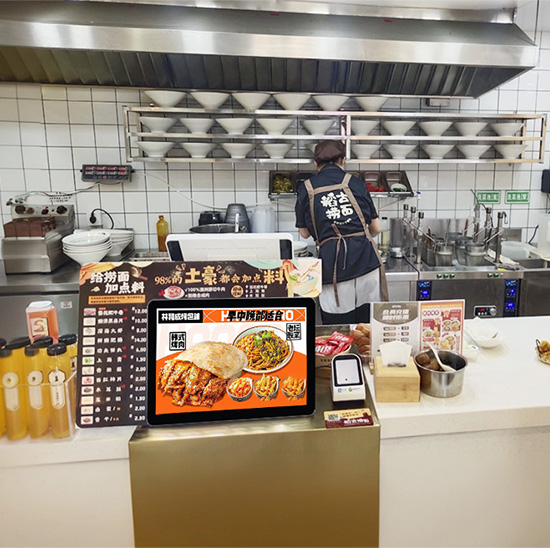In component assembly environments—where workspace is at a premium, precision is non-negotiable, and every second of downtime impacts productivity—Compact Industrial HMI Screens have emerged as a critical solution. Unlike bulkier traditional HMI systems that consume valuable bench or machine space, these streamlined screens deliver full-featured human-machine interaction (HMI) in a compact form factor. For manufacturers assembling small to medium components—from electronics parts and automotive widgets to medical devices—they centralize process control, display real-time data, and guide technicians through assembly steps without crowding workstations. Whether deployed in high-density assembly lines, benchtop work cells, or portable testing stations, Compact Industrial HMI Screens bridge the gap between space efficiency and operational power. This article explores their core features, key applications, and transformative benefits, helping manufacturing managers and operations teams select HMI solutions that enhance component assembly performance.

Core Features of Compact Industrial HMI Screens for Component Assembly
1. Space-Saving Design Without Sacrificing Functionality
The defining advantage of Compact Industrial HMI Screens is their ability to deliver full HMI capabilities in a minimized footprint:
Compact form factors: Available in 5–10 inch screen sizes (ideal for benchtops) and slim profiles (as thin as 25mm), fitting into tight spaces between assembly tools, fixtures, or machine enclosures.
Flexible mounting options: Panel-mount, arm-mount, or VESA-mount designs adapt to diverse setups—from embedded installation in small assembly machines to wall-mounting above crowded workbenches.
Integrated components: Combined display and controller units eliminate the need for separate processing hardware, reducing clutter and simplifying setup.
2. Rugged Construction for Assembly Environment Durability
Component assembly floors pose unique risks—dust, minor impacts, and constant use—and these HMI screens are built to endure:
Industrial-grade build: 2.5mm tempered glass screens resist scratches from tools or component parts, while reinforced plastic or aluminum housings withstand accidental knocks.
Environmental resilience: IP65-rated enclosures block dust, coolant mist, and minor fluid spills common in electronics or automotive component assembly, ensuring reliable operation.
Resistência à vibração: Compliant with IEC 60068-2-6 padrões, the screens maintain performance amid vibration from nearby assembly machines or robotic arms.
3. Precise Control & Real-Time Data Visualization
Component assembly demands accurate process monitoring and instant adjustments—and these HMI screens deliver:
High-resolution displays (1024×600 to 1920×1080): Render detailed assembly guides, part diagrams, and real-time metrics (Por exemplo, torque values, sensor readings) with crisp clarity, even on smaller screens.
Low-latency touch response (≤3ms): Ensures immediate execution of commands—from adjusting machine parameters to confirming assembly steps—critical for maintaining assembly rhythm.
Color-coded data displays: Bold color coding (Por exemplo, green for “in spec,” yellow for “warning,” red for “error”) lets technicians quickly identify process status without squinting at small text.
4. Seamless Integration with Assembly Tools & Systems
Interoperability with existing assembly equipment is key for operational efficiency—and these HMI screens integrate seamlessly:
Industrial protocol support: Compatible with PROFINET, Ethernet/IP, Modbus, and CANopen, syncing with PLCs, torque wrenches, vision inspection systems, and small assembly robots (Por exemplo, collaborative robots like cobots).
MES/quality system integration: Automatically logs assembly data (Por exemplo, part serial numbers, torque readings, pass/fail status) into manufacturing execution systems (MES) or quality management software (QMS) like Siemens Opcenter.
Peripheral compatibility: Connects to barcode scanners, label printers, and foot pedals (for hands-free operation) to create end-to-end assembly workflows.
5. User-Centric Interfaces for Assembly Efficiency
Designed with component assembly technicians in mind, these screens prioritize usability:
Simplified, task-specific dashboards: Customizable interfaces display only relevant data (Por exemplo, “Torque Setting: 5 Nm” or “Step 3: Insert Pin”) to reduce cognitive load.
Step-by-step assembly guidance: Visual prompts (images, videos, or text) walk technicians through complex assembly sequences, reducing training time and errors.
Gloved-hand compatibility: Enhanced capacitive or resistive touch technology works with nitrile, latex, or leather gloves, eliminating the need to remove PPE mid-task.
Key Applications of Compact Industrial HMI Screens in Component Assembly
1. Electronics Component Assembly (Circuit Boards, Sensores)
In electronics manufacturing—where workstations are crowded with soldering irons, tweezers, and test equipment—these HMI screens streamline precision work:
Process parameter control: Displays and adjusts soldering temperatures, pick-and-place machine speeds, or adhesive dispensing amounts, ensuring consistent component bonding.
Quality check guidance: Shows pass/fail criteria for sensor testing or circuit continuity checks, with touch-enabled logging of results linked to component serial numbers.
Inventory tracking: Scans component barcodes to confirm stock levels and ensure correct part usage (Por exemplo, matching resistors to circuit board models).
2. Automotive Component Assembly (Fasteners, Housings, Wiring Harnesses)
For automotive component production—where space is limited on high-density assembly lines—these HMI screens centralize control:
Torque monitoring: Connects to smart torque wrenches to display real-time torque values during fastener installation, triggering alerts if values deviate from specs.
Wiring harness assembly: Guides technicians through wire routing sequences with digital diagrams, reducing cross-wiring errors and rework.
Batch tracking: Links assembly data (Por exemplo, batch numbers, supplier info) to vehicle VINs via touch-enabled data entry, simplifying traceability.
3. Medical Device Component Assembly (Catheters, Implants, Diagnostic Parts)
In medical component manufacturing—where precision and compliance are critical—these compact HMI screens ensure accuracy:
Sterile environment compatibility: Sealed designs with smooth surfaces are easy to clean and disinfect, meeting FDA and ISO 13485 standards for medical manufacturing.
Process validation: Logs every assembly step (Por exemplo, “Glue Application: 0.5ml”) and technician sign-off, creating audit trails for regulatory compliance.
Micro-assembly guidance: High-resolution displays zoom into tiny component details (Por exemplo, catheter lumens) to guide precise positioning.
4. Benchtop & Portable Assembly Stations
For small-batch or custom component assembly—where workstations are often mobile or multi-purpose—these HMI screens offer flexibility:
Portable setup: Lightweight designs (as low as 0.8kg) work with battery-powered assembly tools for on-site or field assembly tasks.
Multi-task support: Quick-switch between different component assembly templates (Por exemplo, “Sensor A” vs. “Sensor B”) with one touch, adapting to changing production needs.
Technician-specific profiles: Stores individual user preferences (Por exemplo, screen brightness, language) for shared workstations.
Benefits of Compact Industrial HMI Screens for Component Assembly
1. Maximized Workspace & Increased Assembly Density
By reducing HMI footprint, these screens unlock tangible space benefits:
Workstations can accommodate 20–30% more assembly tools or fixtures, increasing production capacity without expanding floor space.
High-density assembly lines can add more work cells (up to 15% more) with compact HMI screens, boosting overall output.
2. Reduced Assembly Errors & Rework Costs
Precision guidance and real-time monitoring cut waste and improve quality:
Step-by-step visual guidance reduces human error by 40–50%, lowering rework costs for high-value components (Por exemplo, eletrônica, medical parts).
Real-time alerts for out-of-spec parameters (Por exemplo, incorrect torque) prevent defective components from moving to downstream processes, saving 25–35% in rework labor.
3. Enhanced Technician Productivity
Streamlined interfaces and space-efficient design boost workflow speed:
Technicians spend 15–20% less time navigating complex HMI menus, focusing more on assembly tasks.
Reduced clutter and intuitive controls cut training time for new staff by 30%, ensuring faster onboarding.
4. Simplified Compliance & Traceability
Component manufacturers face strict quality and audit requirements—and these HMI screens simplify adherence:
Automated data logging creates comprehensive audit trails for ISO 9001, IATF 16949, or FDA regulations, reducing audit preparation time by 50%.
Part serial number tracking (linked to HMI data) enables targeted recalls and root-cause analysis for defective components.
FAQs About Compact Industrial HMI Screens for Component Assembly
Q1: Will a 5–10 inch compact HMI screen be large enough for detailed assembly guides?
A1: Yes. Our high-resolution (1024×600+) screens render detailed images and text clearly, with zoom functionality for close-up views of small components or complex steps.
Q2: Are these compact HMI screens compatible with our existing cobots and torque tools?
A2: Absolutely. They support all major industrial protocols and integrate seamlessly with leading cobot brands (Por exemplo, Universal Robots, Doosan) and smart torque tools (Por exemplo, Atlas Copco). Our team verifies compatibility.
Q3: Can we customize the interface for different component assembly tasks?
A3: Yes. We offer pre-configured templates for common tasks (Por exemplo, electronics soldering, fastener installation) and user-friendly software to create custom dashboards, step guides, and data fields.
4º trimestre: How durable are these screens in dusty electronics assembly environments?
A4: All models feature IP65-rated enclosures that block dust and particulate matter. The tempered glass screen and sealed housing ensure reliable operation even in high-dust settings.
Q5: What is the typical lifespan of these compact HMI screens in 24/7 assembly operations?
A5: With industrial-grade components, they have a lifespan of 7–10 years in continuous operation. Most models include a 3–5 year warranty covering defects and performance issues.
Conclusion
Compact Industrial HMI Screens redefine what’s possible in component assembly—delivering full HMI power in a space-saving design that adapts to tight workspaces without compromising precision or durability. For manufacturers struggling with crowded workstations, high error rates, or inefficient process control, these screens are a strategic investment that boosts productivity, improves quality, and maximizes floor space. Whether assembling electronics, automotive parts, or medical devices, Compact Industrial HMI Screens empower technicians to work faster, more accurately, and with greater confidence.
Ready to optimize your component assembly workstations with space-saving, high-performance HMI screens? Fill out the form on our website to connect with our industrial technology experts. We’ll assess your assembly setup, demonstrate integration with your existing tools, and provide a customized solution proposal—helping you elevate efficiency and precision in your component manufacturing operations.

